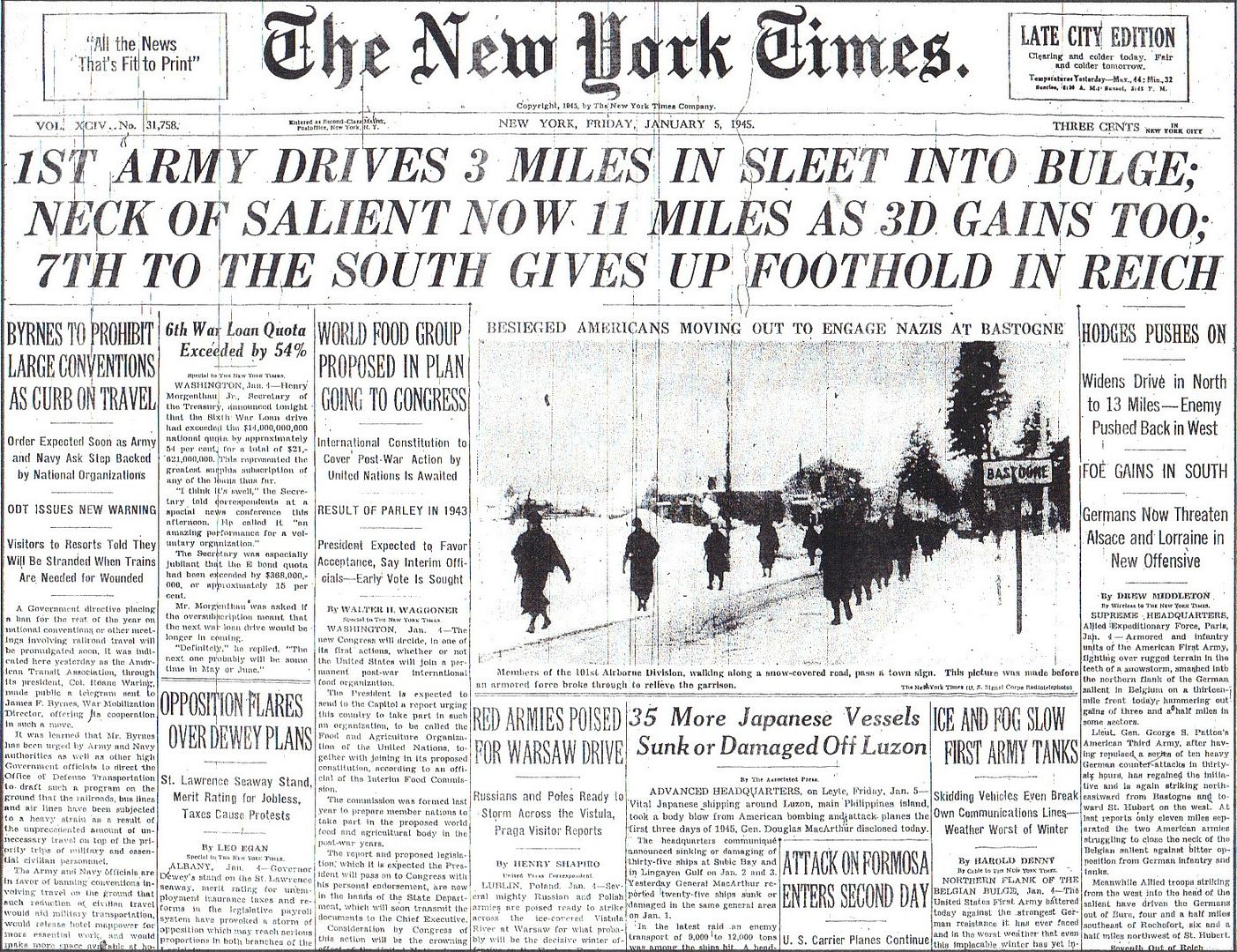
Posted on 01/05/2015 4:31:14 AM PST by Homer_J_Simpson

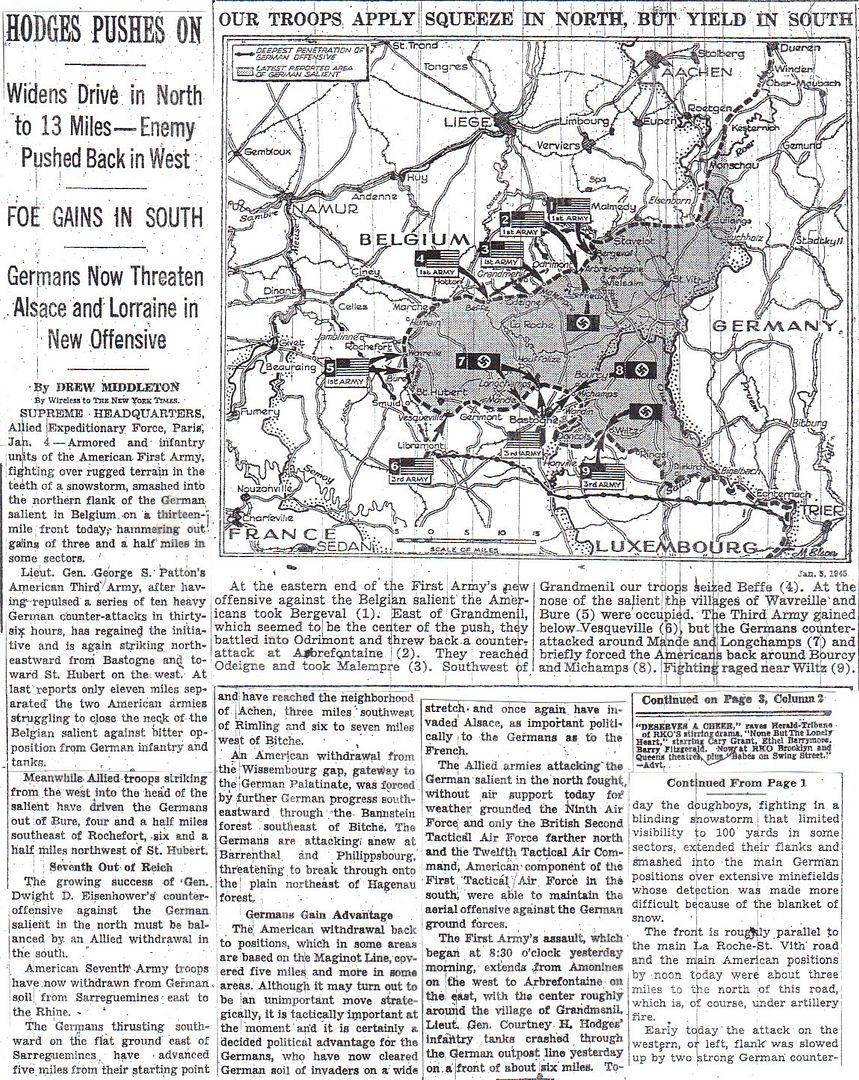
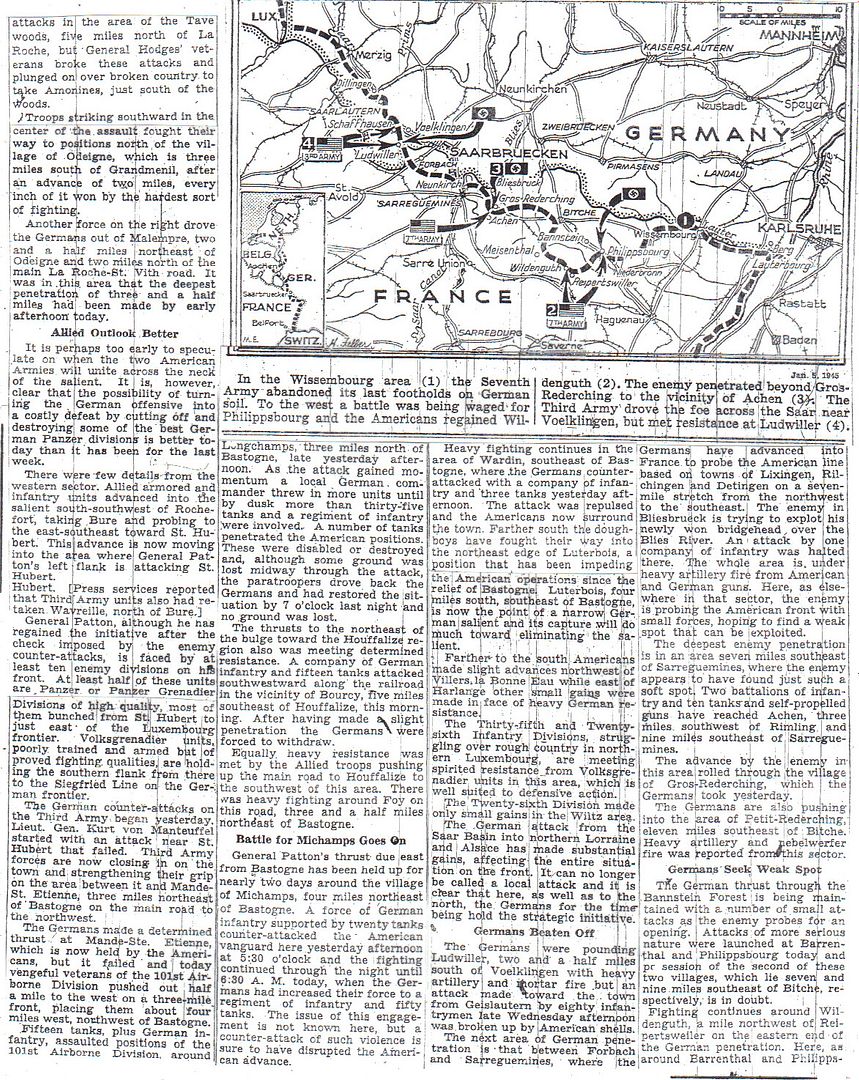
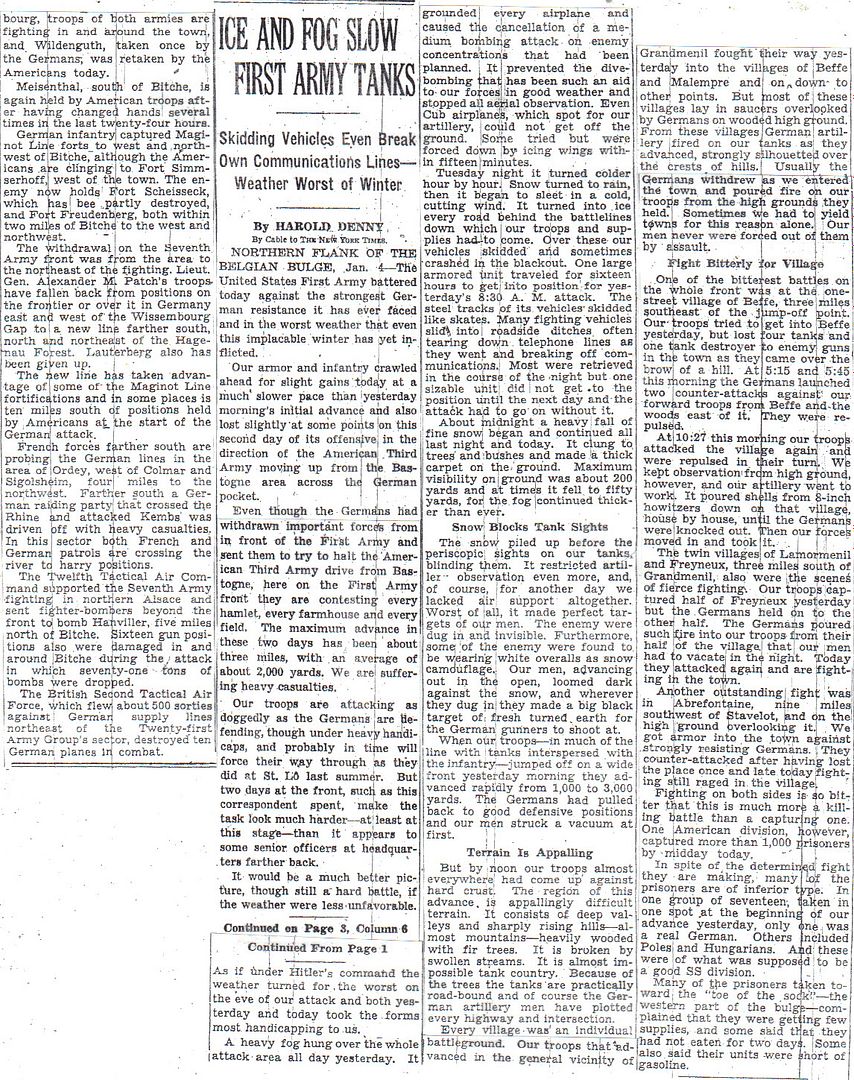
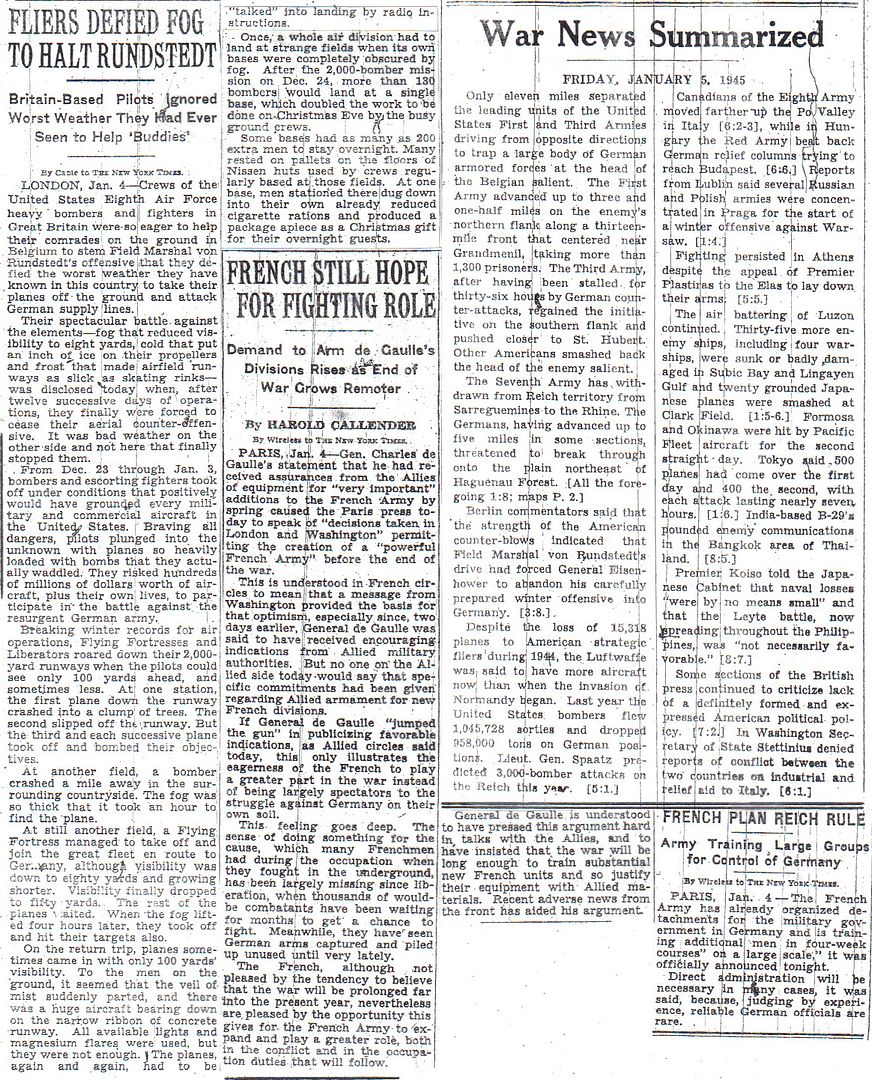
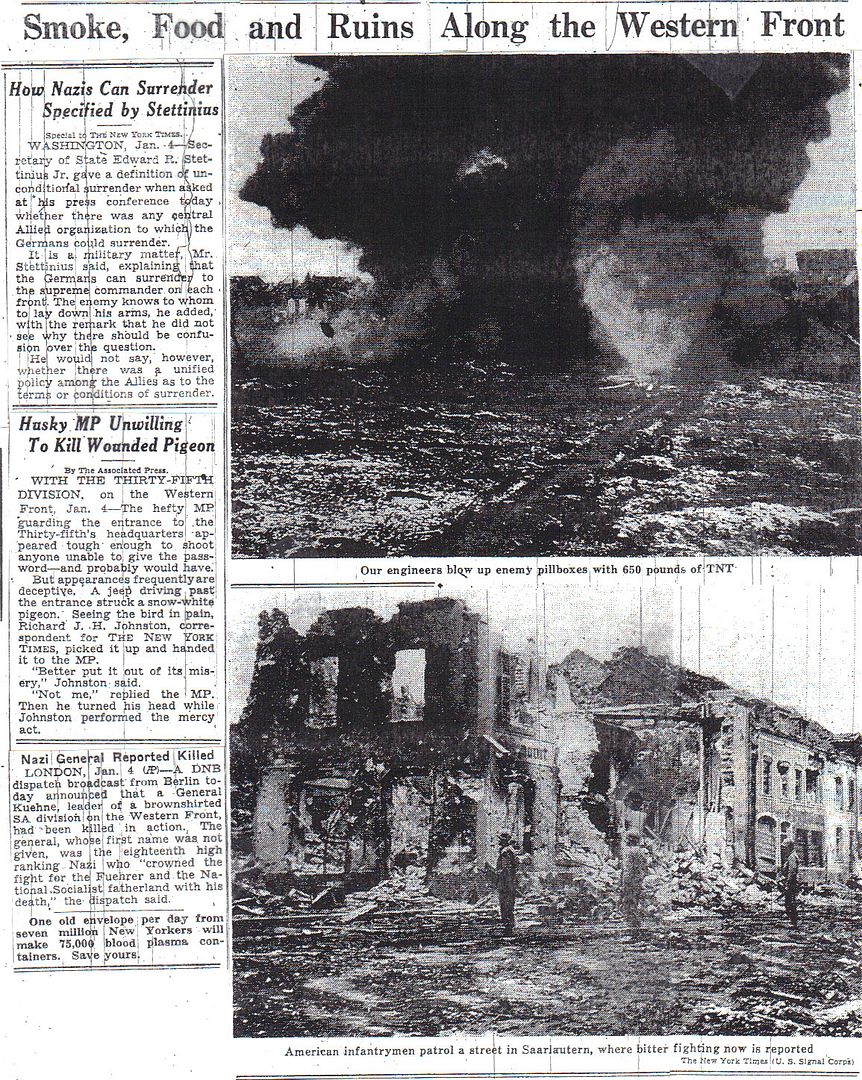
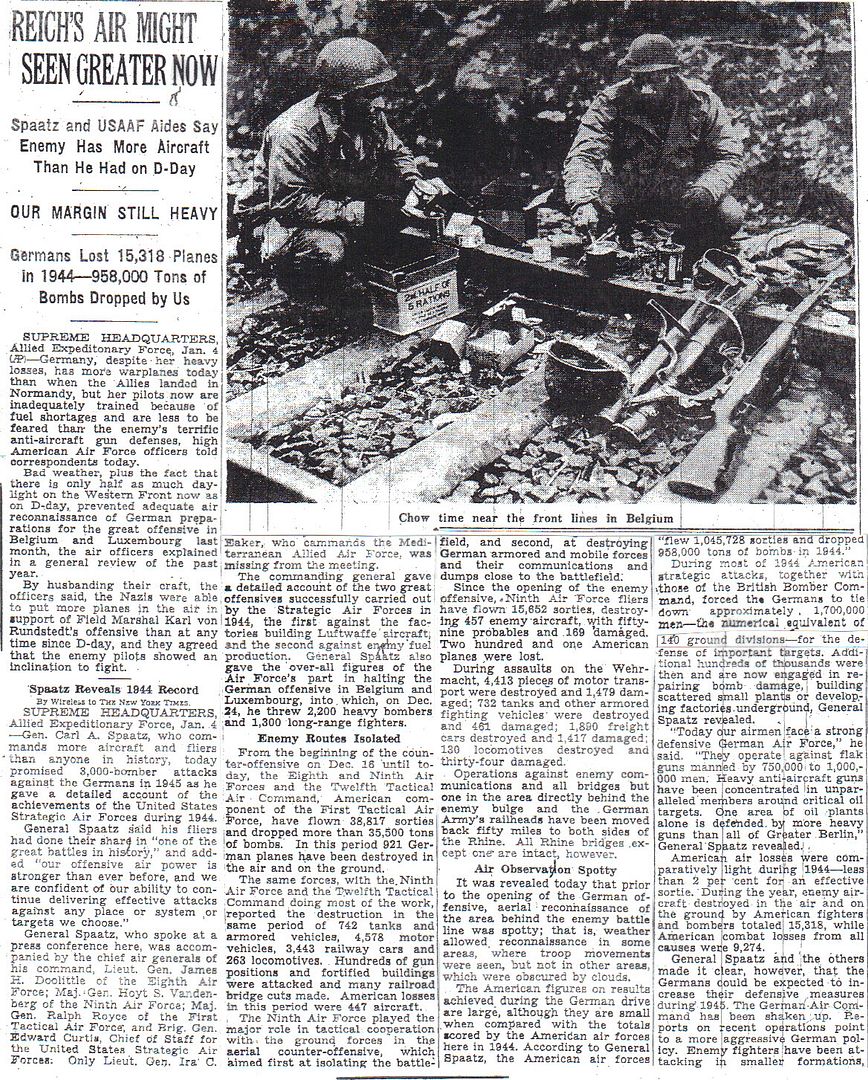
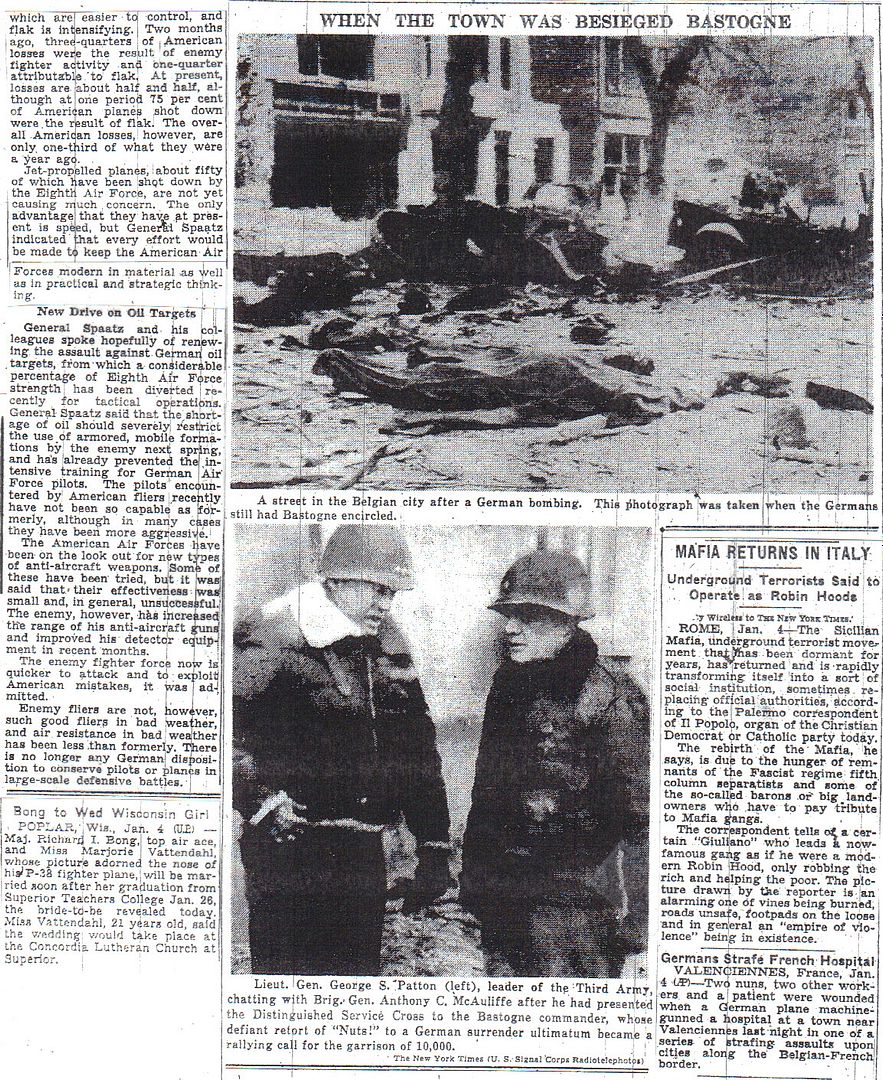
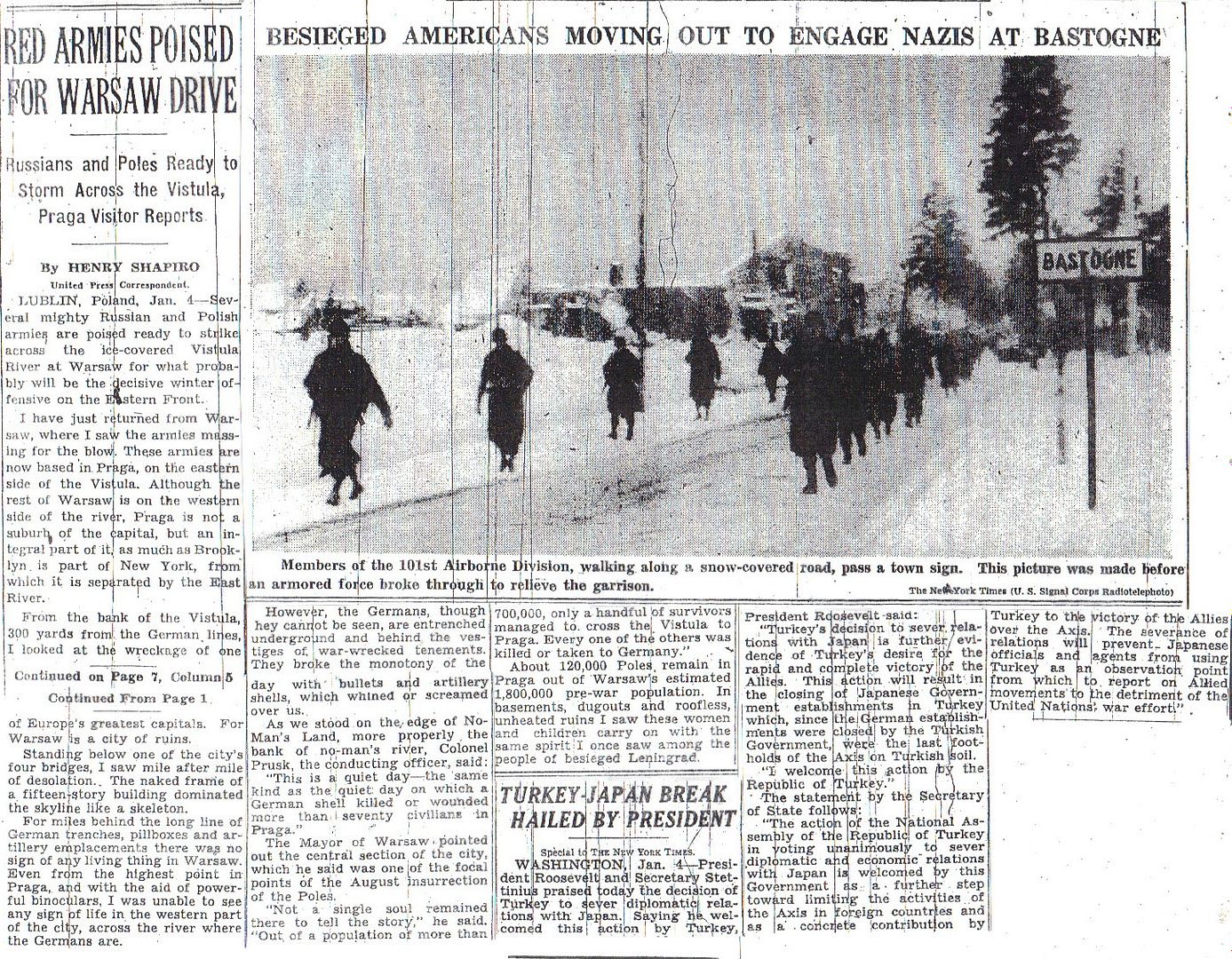
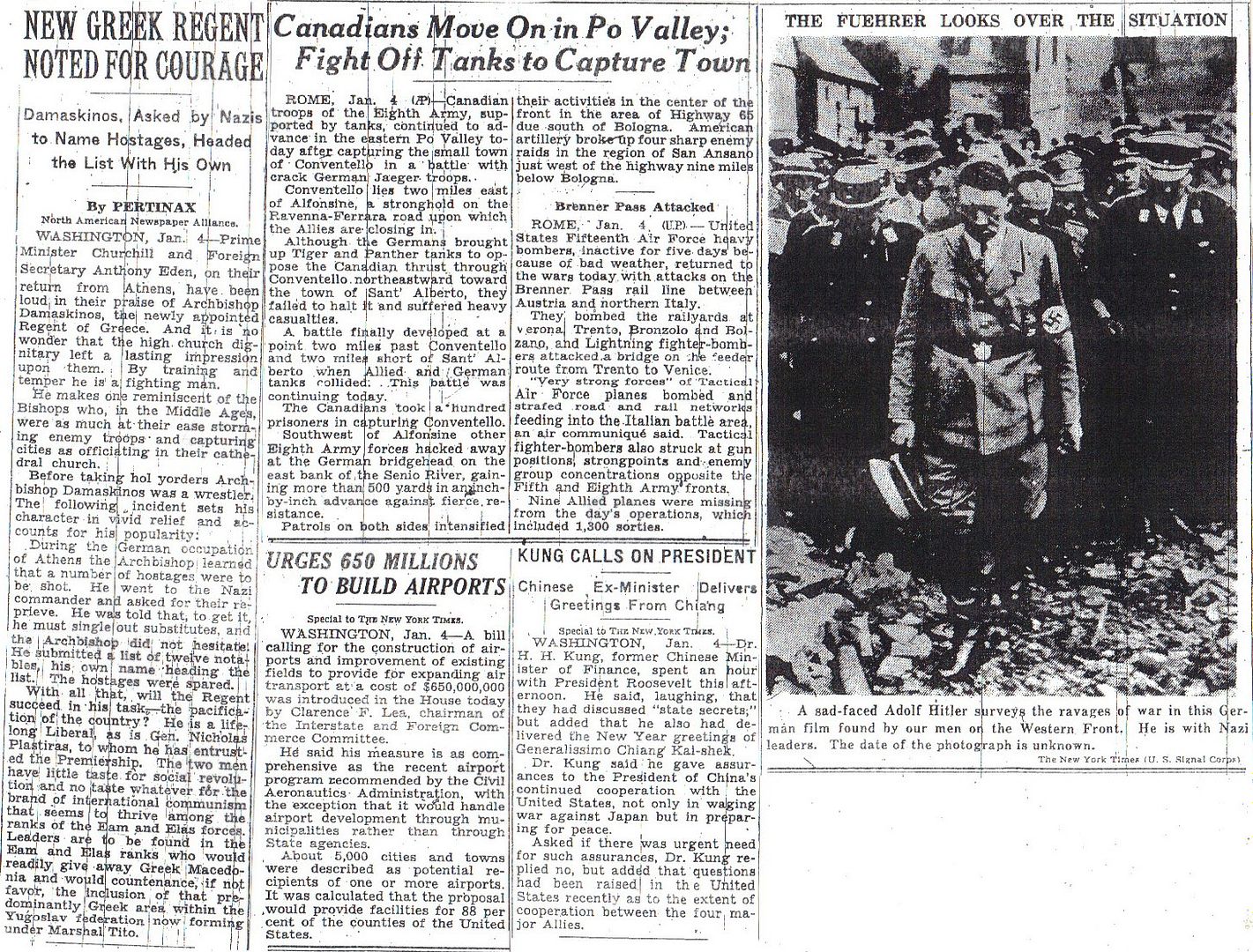
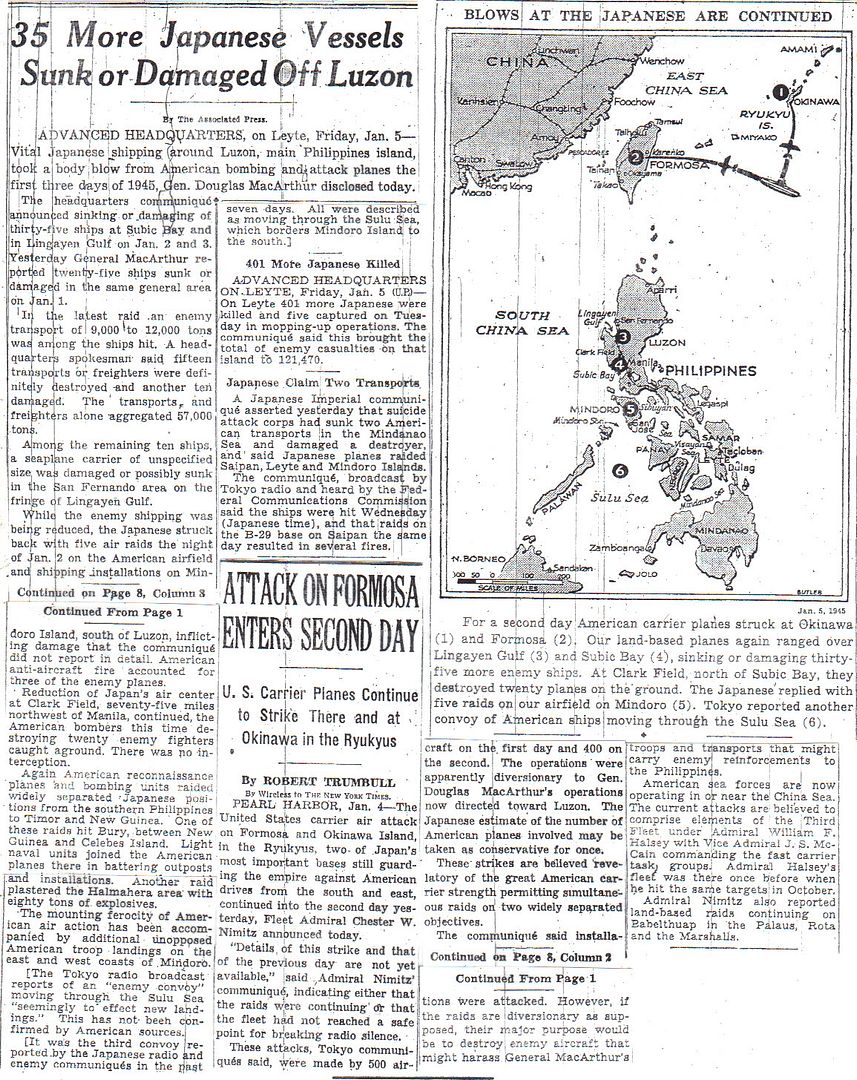
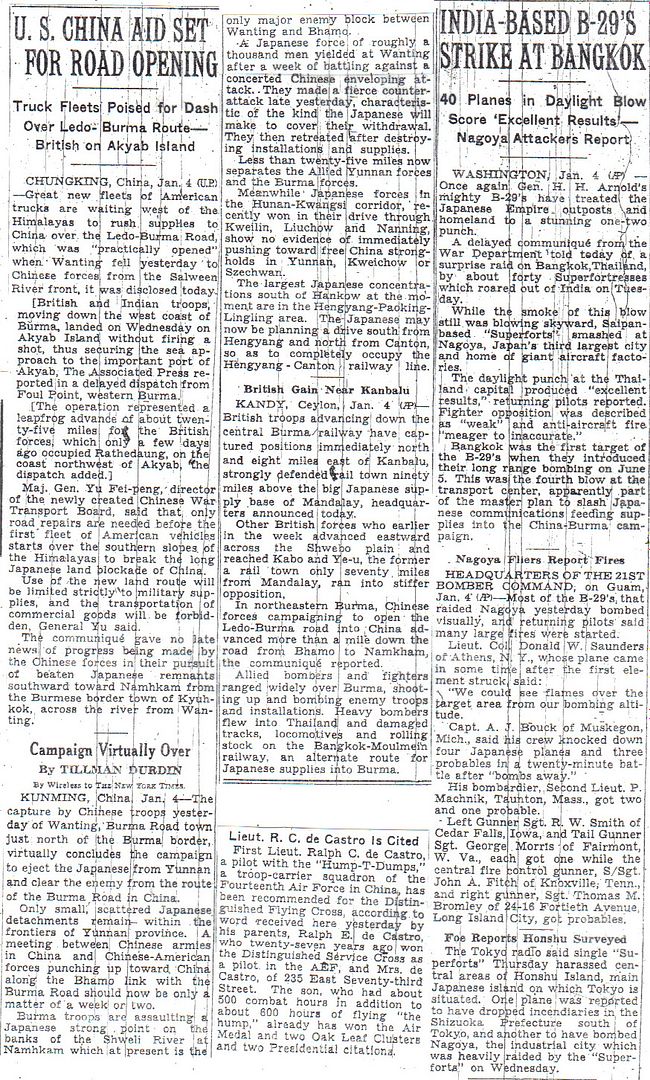
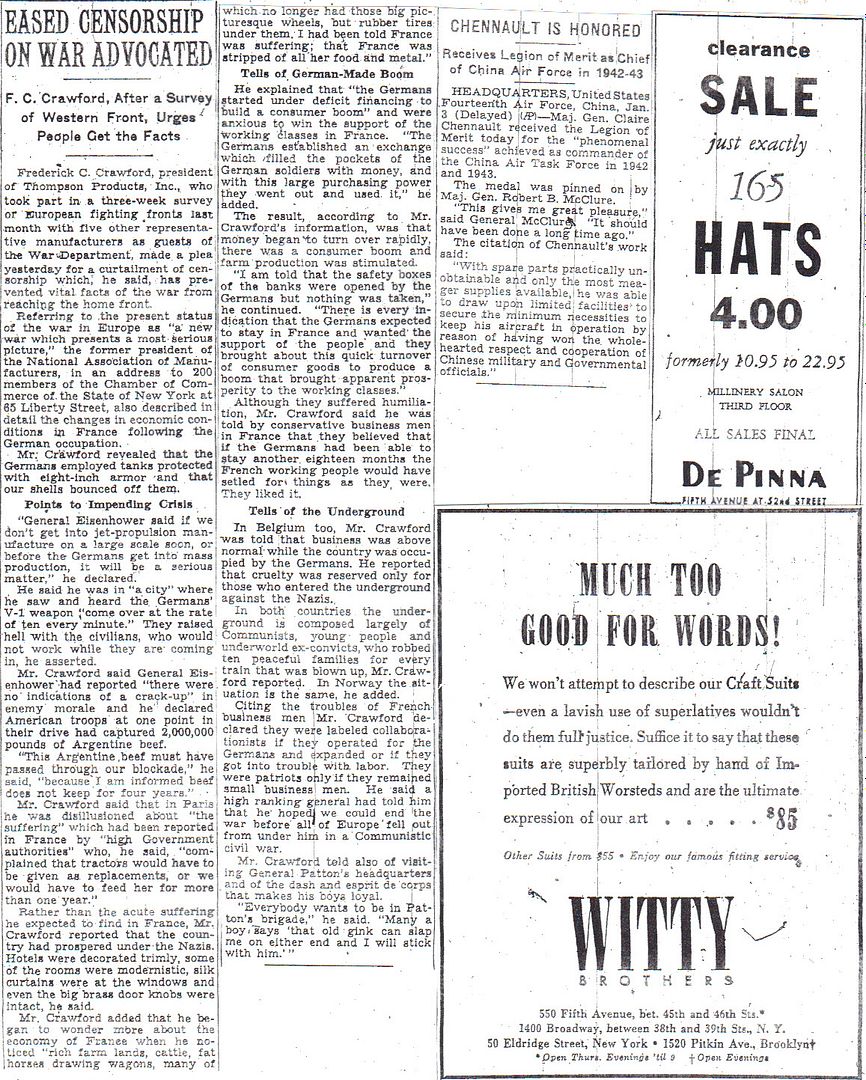

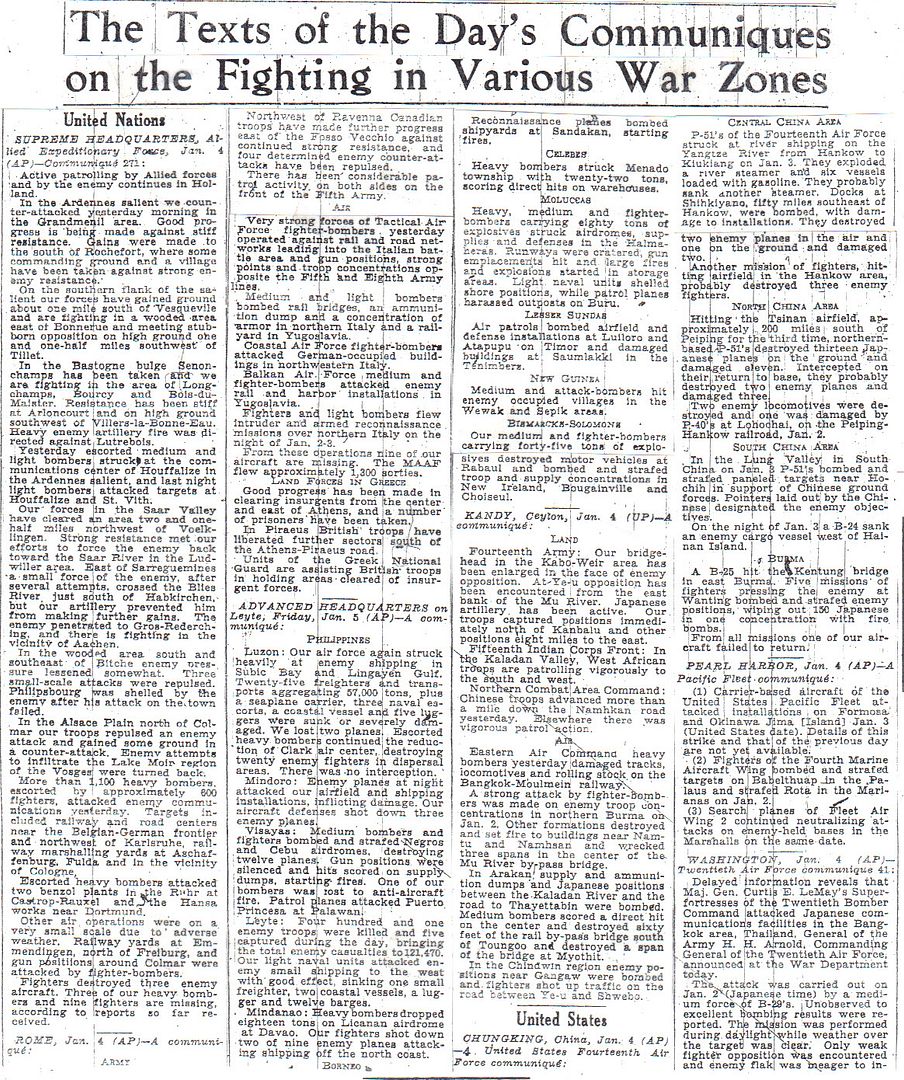
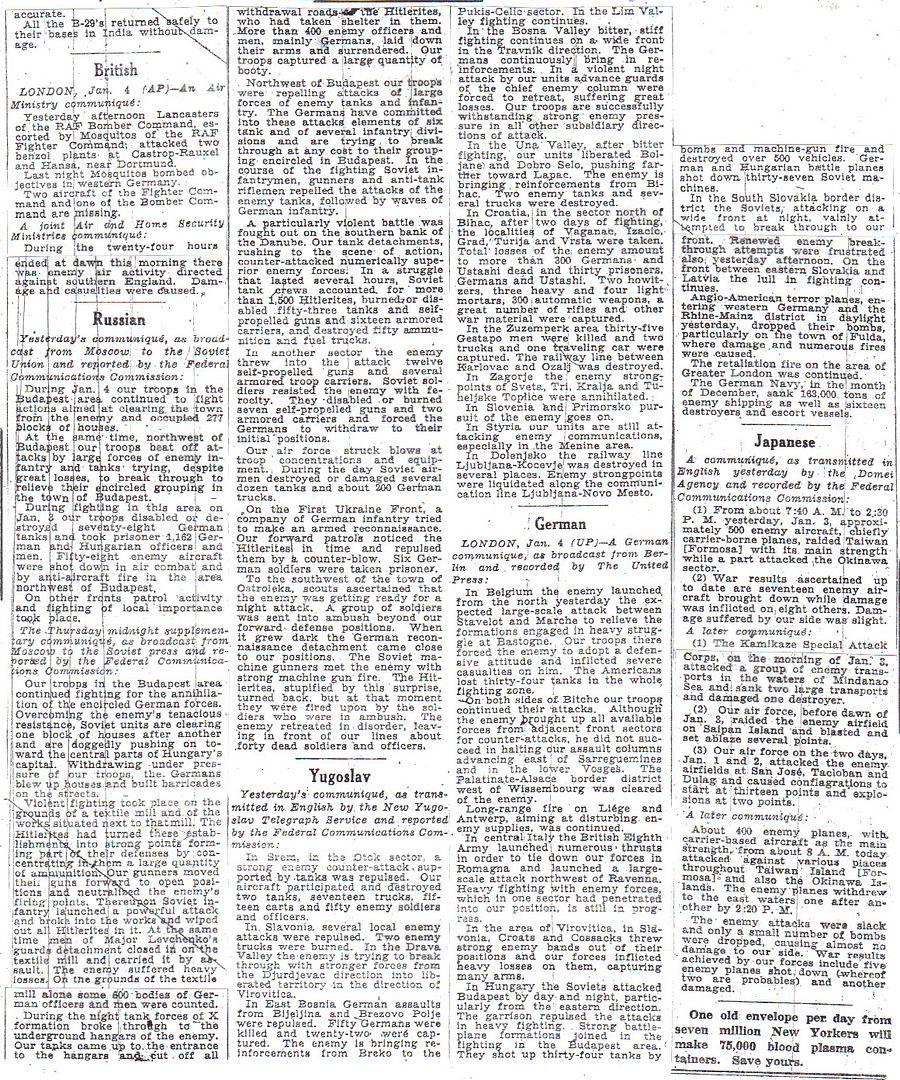
http://www.etherit.co.uk/month/0/05.htm
January 5th, 1945 (SATURDAY)
UNITED KINGDOM: Greenwich, London: Construction begins on Britain’s first prefabricated houses. The UK and US announce continued support for the exile government in London. The USAAF Ninth Air Force’s 9th Bombardment Division attacks rail bridges at Ahrweiler, Simmern, and Bullay, Germany, and communications centres at Gouvy, Houffalize, and near Durler, Belgium, and Massen, Luxembourg. Fighters escort the bombers and VIII Bomber Command bombers, fly armed reconnaissance, attack airfields, communications centres, traffic concentrations, and other targets, and support the US III and VIII Corps west and east of Bastogne and the 2d and 3d Armoured Divisions near Manhay, Belgium.
FRANCE: German forces recross the Rhine and re-enter Alsace in the Gombsheim area.
The French First Army is to take responsibility for the defence of Strasbourg upon relief of U.S. elements in that area by the French. Relief is scheduled for 2400 hours but is interrupted by a German attack.
In the U.S. Seventh Army area, XV Corps clears the Germans from Frauenberg and Gros Rederching. The VI Corps makes slow progress against the Bitche salient in the 45th Infantry Division sector. Most of Wingen and the rest of Philippsbourg are cleared. On the corps right flank, the Germans establish a bridgehead across the Rhine River in the Gambsheim area, crossing between Kilstett and Drusenheim and overrunning Offendorf, Herrlisheim, and Rohrweilcr. Task Force Linden, 42d Infantry Division, hit while executing reliefs, launches a two-pronged assault toward Gambsheim. Task Force A, VI Corps, moves from Weyersheim to the west bank of the Landgraben Canal; Task Force B, VI Corps, attacks from Kilstett but is stopped just north of there.
BELGIUM: Ardennes: The Luftwaffe opened the New Year with Bodenplatte, an attack by 1,035 fighters and bombers on 27 Allied airfields in Belgium and southern Holland. It knocked out 156 Allied aircraft, but cost 277 of its own planes, which were either shot down by the Allies or by its own Flak. It could be the end of German air power in the west.
When Hitler was planning his Ardennes offensive, Göring promised a thousand aircraft, Hitler, recalling Göring’s earlier inflated promises, cut the figure to 800. At best, though, the Germans could never have offered more than a token resistance to the Allies, who can send up thousands of bombers to hit the German Panzers. Mist and low cloud were decisive in assisting the Germans in the first days of the offensive. Then, late on 22 December, six days after the first German attacks, a high wind built up, followed by heavy falls of snow. The skies cleared and the Allied aircraft came out in force, smashing up the Panzer columns at will. The C-47 transports, too, took off, lifting vital supplies to the besieged Americans in Bastogne.
By the middle of the week the weather had closed in again. Two armoured divisions backed by infantry, sent to attack Houffalize, were left struggling; visibility was so poor that not a single aircraft could support the attack.
In the U.S. First Army’s VII Corps area, the 2d Armoured Divisional€™s main effort against Consy makes little headway; elements move toward Dochamps and clear part of Odeigne. The 3d Armoured Division is slowed by rear-guard action in Bois de Groumont but seizes Lavaux and enters Lierneux. The 75th Infantry Division moves to the Aisne River. In the XVIII Corps (Airborne) area, the 82d Airborne Division makes progress all along line and repels counterattacks near Bergeval.
In U.S. Third Army’s VIII Corps area, the 87th Infantry Division meets resistance near Bonnerue and Pironpré, west of Bastogne. The rest of the corps maintains defensive positions. In the III Corps area, the 35th Infantry Division continues to fight for negligible gains.
During the night of 5/6 January, the USAAF Eighth Air Force flies Mission 782: four B-24 Liberators and a B-17 Flying Fortress drop leaflets during the night over south-eastern Belgium.
GERMANY: The USAAF Eighth Air Force flies Mission 781: 749 B-17 Flying Fortresses and 370 B-24 Liberators, escorted by 584 P-51 Mustangs, are dispatched to bomb rail targets and airfields in central Germany. One B-17 and one P-51 are lost. The bombers hit 29 different targets, the heaviest Niederbreisig Airfield hit by 124 B-17s.
During the day, RAF Bomber Command dispatches 160 Lancasters to bomb the marshalling yards at Ludwigshafen; 152 bomb the target with the loss of two aircraft.
During the night of 5/6 January, RAF Bomber Command dispatches 664 aircraft, 340 Halifaxes, 310 Lancasters and 14 Mosquitos, to bomb Hannover; 639 bomb the target with the loss of 23 Halifaxes and eight Lancasters, 4.7 per cent of the force. This is the first large raid on Hannover since October 1943. In other raids, 131 Lancasters and nine Mosquitos are sent to bomb Houffalize, a bottleneck in the German supply system in the Ardennes; 99 bomb the target with great accuracy; two Lancasters are lost. Mosquitos are also active during the night: 60 of 69 dispatched bomb Berlin, eight hit Neuss and six bomb a benzine refinery at Castrop Rauxel.
U-3016, U-3017 commissioned.
U-11 stricken at Kiel. Scuttled on 3 May 1945 in the Kiel Arsenal. Wreck broken up.
ITALY: The U.S. Fifth Army orders extensive regrouping. Regimental Combat Team 135 moves from the U.S. IV Corps zone to the U.S. II Corps area, reverting to the 34th Infantry Division. The 86th Mountain Infantry Regiment, 10th Mountain Division, is attached to IV Corps.
In the British Eighth Army area, the British V Corps and Canadian I Corps complete limited attacks to improve the Winter Line positions. The two corps link up along the Senio River between Cotignola and St. Severo. The Canadian I Corps advances to the Reno River except on the extreme right.
GREECE: Athens: A peaceful solution to the civil war which has threatened to destroy Greece seemed likely today with the appearance of a moderate cabinet under a new prime minister, General Plastiras. The new premier has ignored demands from the left-wing ELAS organization for 50% of the cabinet seats and has excluded all extremists. Plastiras urged “all who have been misled and have turned their arms against their country” to return to duty.
YUGOSLAVIA: A USAAF Fifteenth Air Force B-24 Liberators bombs the East marshalling yard at Zagreb; 69 others abort due to total cloud cover over the target; 38 P-51 Mustangs fly cover over the target area; 33 P-38 Lightnings bomb the northern railroad bridge at Doboj; other operations are limited to reconnaissance, supply drops, and escort.
During the night of 5/6 December, 39 RAF heavy bombers of No. 205 (Heavy Bomber) Group bomb the South railroad bridge at Doboj.
U.S.S.R.: The Soviet government recognizes the communist Polish Committee of National Liberation (Polish Polski Komitet Wyzwolenia Narodowego, PKWN), also known as the Lublin Committee, as the Provisional Government of Poland. The U.K. and U.S. announce continued support for the exile government in London, England.
JAPAN: USN Task Force 92 (Rear Admiral John L. McCrea), consisting of the light cruisers USS Concord (CL-10), Richmond (CL-9) and Trenton (CL-11) and eight destroyers, bombards Japanese installations (airfield and fish canneries) at Suribachi Wan, Paramushiro, Kurile Islands. Four USAAF Eleventh Air Force B-24 Liberators fly an air coverage mission for a naval task force on its approach to Paramushiru Island.
CHINA: Two USAAF Tenth Air Force P-47 Thunderbolts join ground forces in attacking artillery positions at Kunlong.
Four USAAF Fourteenth Air Force B-25 Mitchells attack 13 storage buildings at Kengtung; 29 P-40s and P-51 Mustangs hit airfields at Hankow and Wuchang claiming 50 aircraft destroyed in the air and on the ground; 23 P-51s and P-38 Lightnings hit the airfield and other targets in Samah Bay area on Hainan Island, claiming 11 aircraft destroyed and 30 P-40s and P-38s attack various targets of opportunity around Sinsiang, and Kengtung.
BURMA: Four weeks after crossing the Chindwin river the 19th Indian Division is poised to enter Shwebo. After advancing 90 miles east to Indaw, where it linked up with the 36th Indian Division and Lt Gen Daniel I Sultan’s Chinese divisions on 15 December the 19th moved south and is expected to take Shwebo tomorrow. The Allies have already captured Akyab on the coast this week.
Lt-Gen William Slim, 14th Army Commander, had hoped to bring the main Japanese army in central Burma to battle on the Shwebo Plain, with its back to the Irrawaddy. Instead the Japanese are withdrawing east across the river. Now he is moving IV Corps 200 miles south in Operation Extended Capital, to take Japan’s base at Meiktila and cut Japan’s 15th Army off from the rear.
In the Northern Combat Area Command (NCAC) area, elements of the 90th Regiment, Chinese 30th Division, begin crossing the Shweli River.
Sixteen USAAF Tenth Air Force B-25 Mitchells flying an airfield sweep inflict considerable damage on the Laihka, Aungban, Kunlon, and Mong Long airfields; in the Namhkam sector, two P-47 Thunderbolts join ground forces in attacking artillery positions at Wingkang; nine P-47s damage bypass bridges at Mongmit; over 70 fighter-bombers attack storage areas, tanks and trucks, and troop concentrations at Mong Yaw, Hsenwi, Hpa-Pen, Man Ton, Tunghka, Man Peng, and Longhsu.
USAAF transports fly 550+ sorties to forward bases and frontline areas. Operation GRUBWORM, one of the major transport achievements of the war, is completed on this date one month from its start. The Chinese 14th and 22d Divisions, Chinese Sixth Army Headquarters, a heavy mortar company, a signal company, and two portable surgical hospitals have been airlifted. The move required 1,328 transport sorties; Air Transport Command provided 597 sorties; the air commando squadrons, 488; and Tenth Air Force, 243; the airlift included over 25,000 Chinese soldiers, 396 U.S. soldiers, 1,596 animals, 42 jeeps, 48 howitzers, 48 heavy mortars, and 48 antitank guns; the troops and supplies have been landed at Chanyi, Kunming, Luliang, and Yunnani, China. Only three aircraft were lost during the operation.
Three USAAF Fourteenth Air Force B-25 Mitchells bomb Wan Pa-Hsa and Hawng Luk and fighters attack various targets of opportunity at Wan Pa-Hsa and in the Wanling area. Four P-40s attack fortified hill positions in the Salween area.
FRENCH INDOCHINA: A USAAF Fourteenth Air Force B-24 Liberator bombs the Cap-Saint-Jacques area.
THAILAND: Five USAAF Fourteenth Air Force B-25 Mitchells knock out a bridge at Dara.
EAST INDIES: In major strikes of the day in the Netherlands East Indies (NEI), USAAF Far East Air Forces (FEAF) B-25 Mitchells and P-38 Lightnings and RAAF Beaufighters bomb Menado on Celebes Island while FEAF B-24 Liberators attack Miri Airfield in Sarawak, British Borneo. Numerous smaller strikes are flown throughout the NEI. Fighter-bombers and B-24 Liberators hit the Pombelaa and Tondano area, and targets of opportunity on northeastern Celebes Island. Other FEAF aircraft fly scattered strikes at various targets in Borneo, Lesser Sunda Islands, and Tanimbar Island in the Moluccas Islands.
BONIN ISLANDS: US Task Group 94.9 (Rear Admiral Allan E. Smith), consisting of the heavy cruisers USS Chester (CA-27), Pensacola (CA-24) and Salt Lake City (CA-25) and destroyers USS Cummings (DD-365), David W. Taylor (DD-551), Dunlop (DD-384), Ellet (DD-398), Fanning (DD-385) and Roe (DD-418), together with USAAF Seventh Air Force B-24 Liberators (escorted by P-38 Lightnings) jointly bombard Japanese shipping and installations on Chichi Jima and Haha Jima. Approaching Chichi Jima, USS Dunlap (DD-384), Fanning (DD-386) and Cummings (DD-365) damage a landing ship and USS Fanning sinks her. Off Chichi Jima, USS David W. Taylor is damaged by a mine and USS Fanning by gunfire. Off Iwo Jima in the Volcano Islands, USS Dunlap, Cummings, Ellet and Roe sink a landing ship.
Consolidated B-24 Liberators of the Seventh Air Force’s VII Bomber Command have a busy day with the following activities:
1. They serve as spotter aircraft for USN carrier planes and surface ships that attack Chichi Jima, Haha Jima and Iwo Jima;
2. 22 B-24s bomb Iwo Jima in the morning and afternoon; and 3. They guide seven Lockheed P-38 Lightnings of the 318th Fighter Group based on Saipan to Iwo Jima for strafing attacks.
In addition, PB4Ys (USN B-24s) mount photographic reconnaissance missions against Iwo Jima.
VOLCANO ISLANDS: Twenty two USAAF Seventh Air Force B-24 Liberators from Saipan Island, in morning and afternoon raids, bomb Iwo Jima; seven P-38 Lightnings, with three B-24 as navigational escort, fly a strafing mission against Iwo Jima. In addition, USN PB4Y-1 (B-24) Liberators mount photographic reconnaissance missions against Iwo Jima.
COMMONWEALTH OF THE PHILIPPINES: Heavy cruiser USS Louisville hit by two Kamikazes in Lingayen Gulf.
On Mindoro, Palauan falls to a composite force of guerrillas and 503d Parachute Infantry Regiment troops. Another platoon of Company F, 19th Infantry Regiment, 24th Infantry Division, arrives at Bulalacao and joins in the march northeast toward Paclasan and Dutagan Point.
On Leyte, U.S. Lieutenant General Richard Sutherland, Chief of Staff South West Pacific Area, tells Australian Lieutenant General Sir Frank Berryman, Chief of Staff Advanced Headquarter Allied Land Forces South West Pacific Area, that after Luzon is secured, eight divisions, including the Australian Imperial Force, will be used to conquer Borneo and the Netherlands East Indies.
In major strikes of the day, USAAF Far East Air Forces B-25 Mitchells hit shore installations along Lingayan Gulf, Luzon, while numerous smaller strikes are flown throughout the Philippine Islands. A-20 Havocs and fighter-bombers attack airfields on Luzon, the central Philippine Islands area and Mindanao Island.
PACIFIC: Submarine USS Scorpion believed sunk by Japanese mine. No survivors. In the South China Sea, Japanese air attacks continue against the Lingayen Gulf-bound forces in the teeth of heavy antiaircraft fire and combat air patrol. Of the minesweeping group, an infantry landing craft (gunboat) is damaged by a kamikaze, a small seaplane tender and a fleet tug are damaged by near-misses of suicides. Kamikazes attacking the bombardment and escort carrier groups succeed in damaging heavy cruiser USS Louisville (CA-28) and destroyer USS Helm (DD-388) about 71 nautical miles (131 kilometres) northwest of Subic; escort aircraft carriers USS Manila Bay (CVE-61), about 63 nautical miles (116 kilometres) west northwest of Subic, and USS Savo Island (CVE-78), about 77 nautical miles (142 kilometres) west-northwest of Subic; and destroyer escort USS Stafford (DE-411), about 55 nautical miles (101 kilometres) south-southwest of Subic. Suicides also damage Australian heavy cruiser HMAS Australia (D 84) and destroyer HMAS Arunta (I 30). Japanese escort destroyers approach the minesweeping group but turn away at approach of destroyer USS Bennion (DD-662) and Australian frigate HMAS Gascoyne (K 354) and sloop HMAS Warrego (L 73); subsequently, planes from TG 77.4 (escort carrier group) sink HIJMS Momi 20 nautical miles 37 kilometres) southwest of the entrance to Manila Bay and damage HIJMS Hinoki and Sugi west of Manila Bay.
Two PB4Y-1 Liberators of Patrol Bombing Squadron One Hundred Eleven (VPB 111) based on Tinian Island, Mariana Islands, sink Japanese midget submarine Ha.71 about 2 nautical miles (3,7 kilometres) southwest of Chichi Jima, Bonin Islands.
U.S.A.: Destroyer USS Stickell laid down.
It seems to me the debate is over. The Tiger and Panther were better than the Sherman and the concept of a "tank destroyer" without a rotating turret wasn't very useful. But at this point in the war we can't change any of that, just outproduce the Nazis and overwhelm them with numbers.
I saw "Fury" last weekend. Not the best war movie ever made, the plot was thin and it dragged in the middle. Still, it was a nice tribute to the WWII tankers who were taking a risk every time they went into combat against superior German tanks. And you get to see the only working Tiger tank left in the world. It was also nice to see Shermans tricked out for WWII combat.
Brad Pitt, "War Daddy," is very loosely based on Sergeant Lafayette Pool, the biggest tanker ace of WWII. He was credited with over 1,000 kills, including 12 confirmed tanks and 258 total armored vehicles. He was awarded the Distinguished Service Cross and just about every medal but the MOH.
When his third tank was shot out from under him his leg was so badly mangled it had to be amputated. But, Sgt. Pool decided civilian life didn't suit him and he rejoined the Army after the war. A former CO got him back into the 3rd Armored Div. and he had a career as a tank mechanic, retiring as a CWO.
Brad Pitt, gah.
Crosley’s Secret War Effort
The Proximity Fuze
http://www.navweaps.com/index_tech/tech-075.htm
“On January 5,1943 Lt. “Red” Cochrane, commanding the aft 5” battery on the light cruiser Helena, shot down a Japanese Val dive-bomber with the second of three salvos of VT-fuzed shells, near Guadalcanal. The fuzes were manufactured by the Crosley Corporation and this was the first kill of enemy aircraft.”
James V. Forrestal, Secretary of the Navy said, “The proximity fuze has helped blaze the trail to Japan. Without the protection this ingenious device has given the surface ships of the Fleet, our westward push could not have been so swift and the cost in men and ships would have been immeasurably greater.”
Scroll down and you will find comparison tables that show kamikaze kills, by proximity fused munitions and other means.
“Generally speaking, Kamikaze actions were at very close range with the aircraft closing fast upon their intended target. These sort of engagements were very difficult for weapons firing time-fuzed ammunition, as the rate of change in the ballistic range to the aircraft also meant that the fuze settings needed to have large changes from one round to the next. Any lag or delay in getting a particular round into the air after its fuze had been set meant that its detonation would be too far away to reach the target aircraft. The VT fuze eliminated that problem, as noted by its far smaller rounds per aircraft rate.”
Beautifully on-point. Thank you.
You’re welcome. I got lucky and found that.
Thanks for bothering to look.
One idea I had was not to try to time those fuses to coincide with the incoming fighters' trajectory at all, but rather to create a wall of exploding flak at one distance, at one area in the sky, that the fighter could not avoid. Stagger the shots' timing a bit so he'd be bracketed--he'd fly right into it.
I don't know if I've given a clear-enough description of this idea, but I'm wondering if it was ever tried. Of course, maybe this method was S.O.P. and I'm just displaying my ignorance, which I'm certainly no stranger to.
But there's a whole lot of sky up there, and anyone's guns have ammunition limitations.
I've seen the pictures of the amount of flak in the sky over Germany, and it's astounding that anyone could encounter that and survive. But more often than not, they did, it would seem.
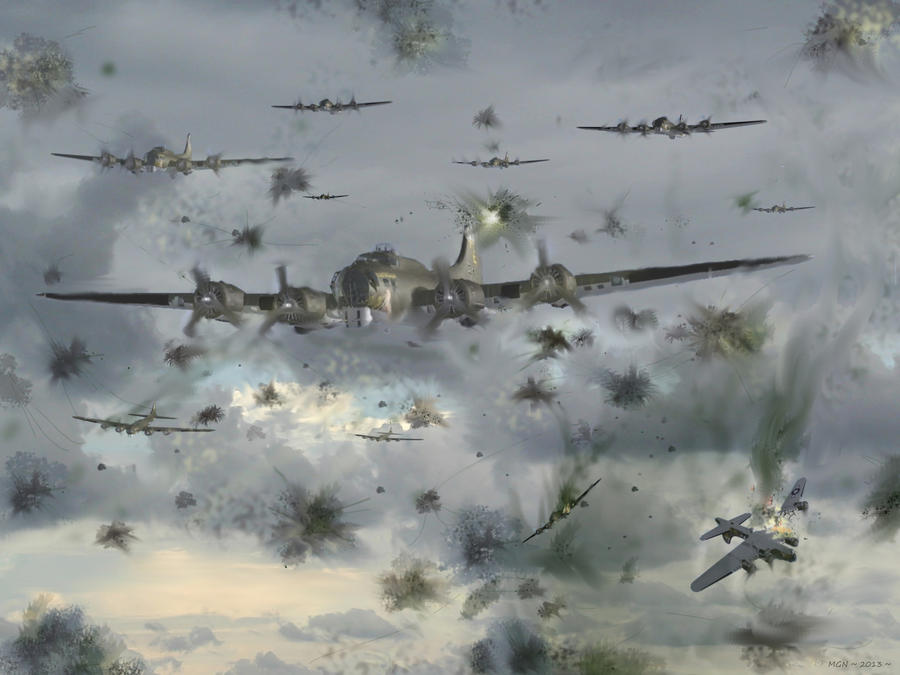
“Two PB4Y-1 Liberators of Patrol Bombing Squadron One Hundred Eleven (VPB 111) based on Tinian Island, Mariana Islands, sink Japanese midget submarine Ha.71 about 2 nautical miles (3,7 kilometres) southwest of Chichi Jima, Bonin Islands.”
My Uncle Ralph, RIP, was in VPB 102 on Tinian first flying Catalinas and then PB4Y-1 Liberators.
My dad was one of those Naval aviator cadet trainees who was preparing for the Japanese invasion in early 1945 in Georgia. That is where he met my mom who at age 16 was the daughter of the base disciplinary officer!
My maternal grandfather (nickname “Admiral”) was a veteran of WWI and served on Jacob Astor’s converted Yacht that was impressed as a sub-chaser. He also went back on active duty to train sailors in the “Korean Conflict” so he retired with active Navy duty in three wars.
Me...I only washed out of the Marine Corps OCS in one war! It was my Navy grandfather who took my onto the Brunswick NAS while going to the PX and took me right under the nose of an F-4 right after they entered service in 1963 that probably made me want to be a Marine Aviator!
BTW, I cannot believe how often Iwo Jima was bombed!
Thanks. It is amazing.
My dad was in a Navy aviation program - released when the war abruptly ended.
Disclaimer: Opinions posted on Free Republic are those of the individual posters and do not necessarily represent the opinion of Free Republic or its management. All materials posted herein are protected by copyright law and the exemption for fair use of copyrighted works.